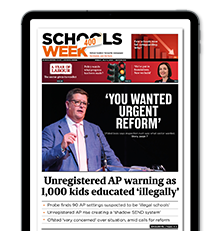Never has so much been asked of school leaders. Mike Armiger sets out how they can protect themselves now and for the long term
It is a time of great uncertainty and challenge for everyone in our community and across the public sector. The focus on the developing crisis that is required of us is intense, but if we allow it to become our only focus, we may be creating longer-lasting problems for ourselves.
My hope is to avoid patronising slogans about wellbeing. As educators, you will have asked dozens of people today how they are. It’s likely someone has asked you too, and stuck around for the answer. We are uniquely caring as a profession, and we are also uniquely self-critical. Both are positive, but both also carry risks.
When I first started in leadership, the distance between how I thought I would react in a crisis and how I actually did was often vast. I dream of that unflappable day, always calm and 20 steps ahead, but the reality is that every minute, every hour, every day, a new challenge is presented that shifts the goalposts from prevention to mitigation. Leading during these times requires us to reflect on our decisions, change course if needed, adapt where required and always create.
People often misinterpret or simplify what resilience is. Rather than a predisposition of character or “grit”, resilience is more about “we” than it is about “me”. (So much for avoiding slogans!) Building coping resources within oneself or supporting someone else to do so is of course important, but building social capital and relational resource is vital for coping in the face of challenge. For those working in the public sector, that’s harder than most. We can easily take for granted that people want to know about, or are able to support us with, the sometimes-momentous decisions we have to make. In truth, many have no idea and some regrettably just don’t care.
Those who support us are vital to our immune response
The unsung heroes are those who support us. Some of course are found in work, but for many, those that we come home to, speak to virtually, connect with and trust are the people who get us through. That is why identifying them is important, especially in times of increased challenge like these. Of course, there is some value in knowing the uniqueness of the challenge and of the role, but even those who can’t fully empathise with the challenges of our role are vital to boosting our immunity.
We need time to rest, for cell renewal to take place, and so much more. This is where our supporters come into their own. They allow us time and space to decompress, and they allow us affection, care, hope and the opportunity to be reassured and understood. Identify and speak with those people where you can, they are invaluable.
In my role across health and education, I am often tasked with helping people find hope and safety in the most difficult of times. At first glance, these are situations where an individual has a distinct lack of both psychological and physical safety. Building that sense of safety and hope is something we best do as a community. We mustn’t inflict it, but we can provide the circumstances in which they show themselves.
I’ve lost count of the number of times that despite everything else happening in people’s lives, they have found it in the most unexpected places. Kindness from a stranger, a pet, a joke, a loved one, nature, reminiscing, social media (#joinin) and so many more. The little things within our grasp are where we can find solace when our world feels like it’s getting away from us. Just as our problems have cumulative effect, so too do our positive interactions.
Social distancing is for the body, not for the mind or soul. You’ll often find me stargazing on the front step with a brew during times of contemplation. It’s amazing the conversations you can have – and who you can have them with – if you make yourself open to them.
If you need help to get started, a simple safety planning format is available at www.stayingsafe.net It is designed for people experiencing significant distress, but many choose to use it for stress, overwhelm and anxiety too.








Your thoughts